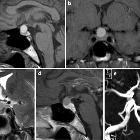zystische Läsionen in der Hypophyse
zystische Läsionen in der Hypophyse
Siehe auch:
- Rathke Zyste
- Tumoren der Hypophysenregion
- verdickter Hypophysenstiel
- Empty-Sella-Syndrom
- Kraniopharyngeom
- epidermale Inklusionszyste
- Pars intermedia-Zyste der Hypophyse
- pituitary region mass with intrinsic high T1 signal
- pituitary MRI - an approach
- mixed cystic and solid pituitary region mass
- purely intrasellar pituitary mass
- zystische Läsionen der Sellaregion
- zystisches Hypophysenadenom
- supraselläre Arachnoidalzyste
- SATCHMO
- solid and enhancing pituitary region masses
- cystic suprasellar mass
 Assoziationen und Differentialdiagnosen zu zystische Läsionen in der Hypophyse:
Assoziationen und Differentialdiagnosen zu zystische Läsionen in der Hypophyse:










